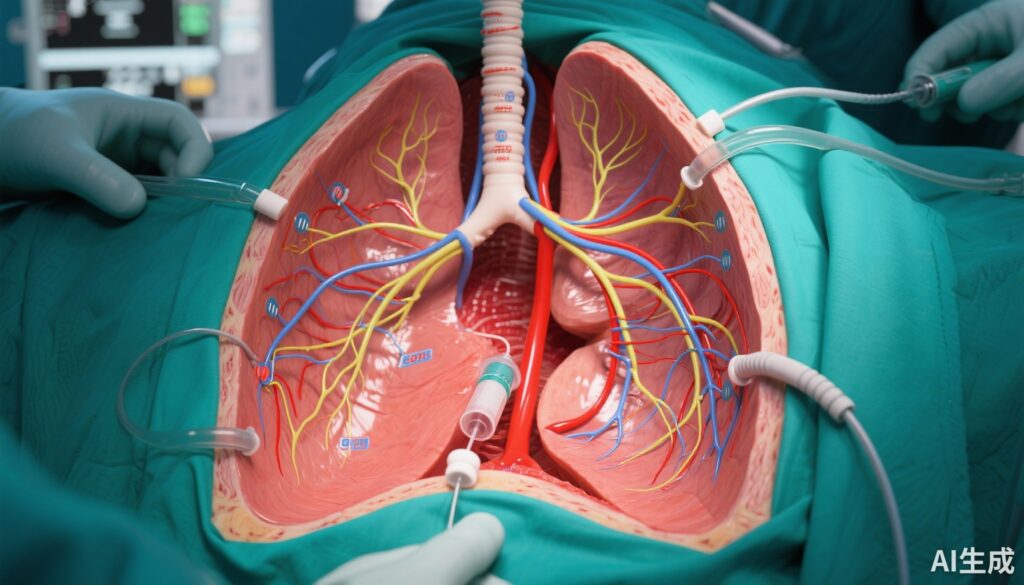Highlight
– Single-shot intercostal nerve block (ICNB) provides noninferior pain relief compared to thoracic epidural analgesia (TEA) after thoracoscopic anatomical lung resection.
– Continuous paravertebral block (PVB) was inferior to TEA in pain control but both PVB and ICNB reduced opioid consumption and enhanced postoperative mobility.
– ICNB was associated with shorter hospital stays without increased complication rates.
– Quality of recovery scores were similar among TEA, PVB, and ICNB groups, supporting ICNB as a practical alternative for enhanced recovery protocols.
Study Background and Disease Burden
Effective postoperative pain management is a critical component of recovery after thoracic surgery. Thoracic epidural analgesia (TEA) has long been considered the gold standard because it provides excellent pain control. However, TEA can be associated with adverse effects such as hypotension, urinary retention, and motor block that may delay mobilization, which conflicts with enhanced recovery after surgery (ERAS) principles. There is a pressing need for less invasive regional analgesic techniques that maintain effective pain control while minimizing side effects.
Continuous paravertebral block (PVB) and single-shot intercostal nerve block (ICNB) have emerged as promising alternatives. Both techniques target the segmental nerves supplying the thoracic wall but differ in invasiveness and duration. Prior to this study, high-quality randomized controlled trial evidence comparing these modalities directly to TEA in thoracoscopic lung surgery was lacking, leaving clinicians without clear guidance on optimal analgesic strategies aligned with recovery goals.
Study Design
This randomized clinical trial, conducted across 11 hospitals in the Netherlands and Belgium from March 2021 to September 2023, enrolled 450 patients undergoing thoracoscopic anatomical lung resection. Patients were randomized in a 1:1:1 ratio to receive continuous PVB, single-shot ICNB, or TEA. The trial employed a noninferiority design to compare pain control, assessed as the mean proportion of pain scores ≥4 on a numeric rating scale during postoperative days 0 to 2. A noninferiority margin was set at an upper limit of 17.5% for the one-sided 98.65% confidence interval (CI). Additionally, the study evaluated quality of recovery (QoR) using the validated QoR-15 questionnaire on postoperative days 1 and 2, with superiority testing planned.
Secondary endpoints included opioid consumption, patient mobilization, complication rates, and length of hospital stay. The intention-to-treat (ITT) population included 389 patients (131 TEA, 134 PVB, and 124 ICNB), with a mean age of 66 years and balanced gender distribution.
Key Findings
Pain Control: The proportion of pain scores ≥4 was lowest in the TEA group (20.7%; 95% CI, 16.5%-24.9%), followed by ICNB (29.5%; 95% CI, 24.6%-34.4%) and highest in the PVB group (35.5%; 95% CI, 30.1%-40.8%). Noninferiority analysis demonstrated that ICNB was noninferior to TEA (upper limit of 16.1% in ITT, 17.0% in per-protocol [PP] analysis), whereas PVB was inferior (upper limits 22.4% ITT; 23.1% PP). This indicates that single-shot ICNB provides pain control comparable to TEA within preset clinical margins, while PVB does not meet noninferiority criteria.
Quality of Recovery: The mean QoR-15 scores were similar between groups (TEA 104.96, PVB 106.06, ICNB 106.85), with no statistically significant differences. This suggests that overall patient-perceived recovery quality in the early postoperative period did not differ substantially based on analgesic technique.
Opioid Consumption and Mobilization: Both ICNB and PVB groups used significantly less opioid medication postoperatively compared with TEA recipients, reducing opioid-associated risks. Furthermore, patients receiving ICNB or PVB exhibited enhanced early mobilization, an important metric for preventing complications such as venous thromboembolism and pneumonia.
Complications and Hospitalization: No significant differences were observed in complication rates among the three groups, indicating comparable safety profiles. Notably, hospitalization duration was shorter in the ICNB group, highlighting a potential advantage in facilitating faster discharge and optimizing healthcare resources.
Expert Commentary
This well-conducted randomized trial provides robust evidence supporting the use of single-shot intercostal nerve block as a practical and less invasive alternative to thoracic epidural analgesia for lung surgery via video-assisted thoracoscopy. The findings align with ERAS principles by balancing effective analgesia with improved functional recovery and reduced opioid dependency.
While continuous paravertebral block showed some opioid-sparing and mobility benefits, its inferior pain control suggests that technical refinements or patient selection might be needed before widespread adoption. It should also be noted that the single-shot nature of ICNB might limit its duration of analgesia compared with continuous techniques, warranting strategies for supplemental pain control after initial effect wanes.
Subgroup analyses and longer-term follow-up could clarify the impact on chronic pain and functional outcomes. Furthermore, the trial’s multi-center design enhances generalizability across diverse clinical settings. However, considerations such as block technique proficiency, local anesthetic pharmacodynamics, and patient-specific factors remain critical for individualized analgesic planning.
Conclusion
In patients undergoing thoracoscopic anatomical lung resection, single-shot intercostal nerve block offers pain control noninferior to thoracic epidural analgesia, with added benefits of reduced opioid consumption, enhanced mobility, and shorter hospitalization. Continuous paravertebral block, although beneficial in some secondary outcomes, did not meet noninferiority criteria for pain relief.
Given the adverse effect profile of TEA and the emphasis on enhanced recovery pathways, ICNB emerges as a viable alternative analgesic strategy. Clinicians should weigh the risks and benefits of each technique and consider patient preferences, surgical factors, and institutional expertise to tailor optimal pain management approaches. Future research should focus on optimizing nerve block protocols and integrating multimodal analgesia to further improve postoperative outcomes.
References
- Spaans LN, Dijkgraaf MGW, Susa D, et al. Intercostal or Paravertebral Block vs Thoracic Epidural in Lung Surgery: A Randomized Noninferiority Trial. JAMA Surg. 2025;160(8):855-864. doi:10.1001/jamasurg.2025.1899
- Wong J, et al. Enhanced Recovery After Thoracic Surgery: A Review of Current Practice and Future Directions. Ann Thorac Surg. 2020;109(5):1474-1483.
- Stewart GG, et al. Regional analgesic techniques for thoracic surgery: a narrative review. Anaesthesia. 2022;77(3):338-346.



